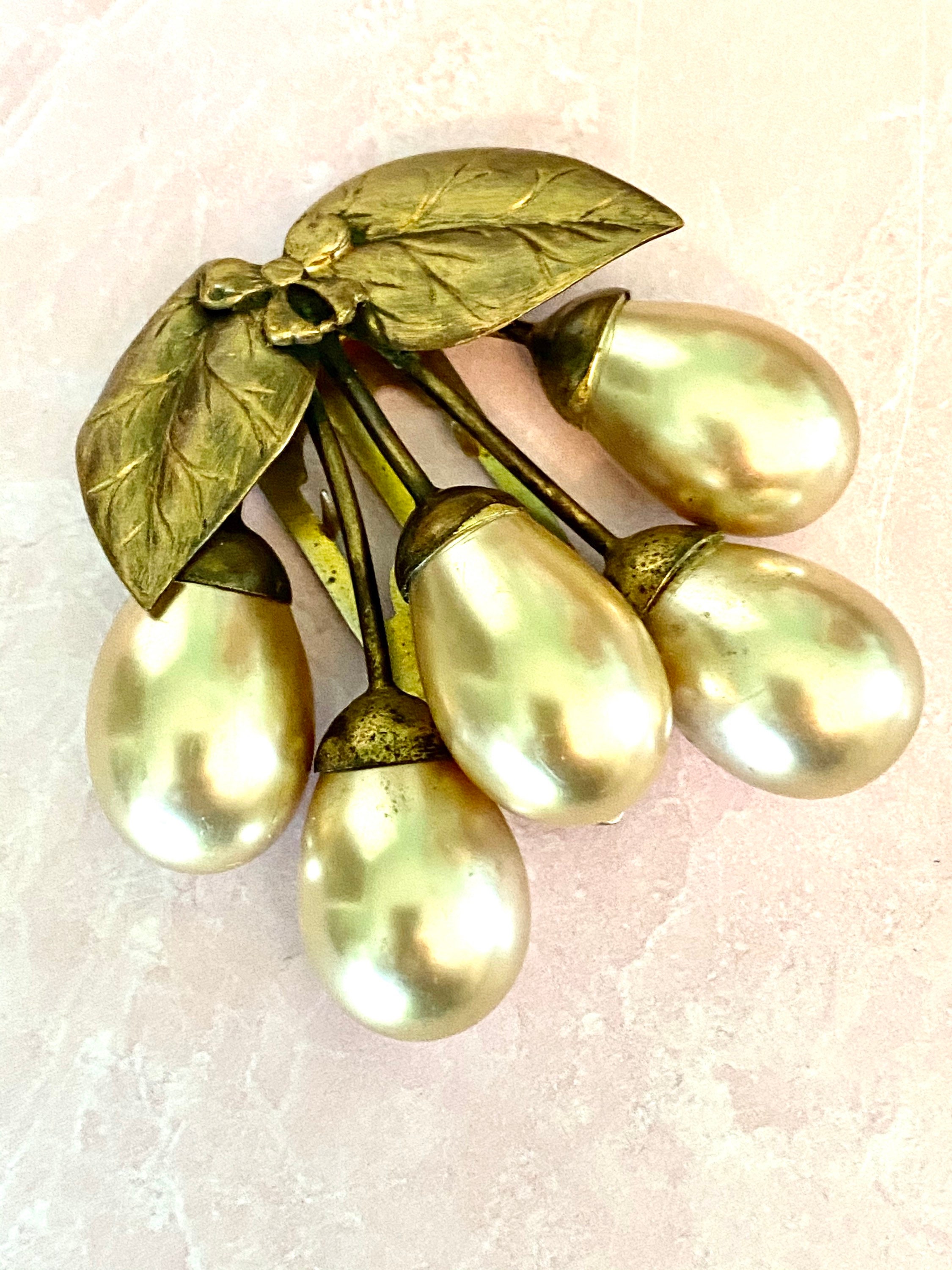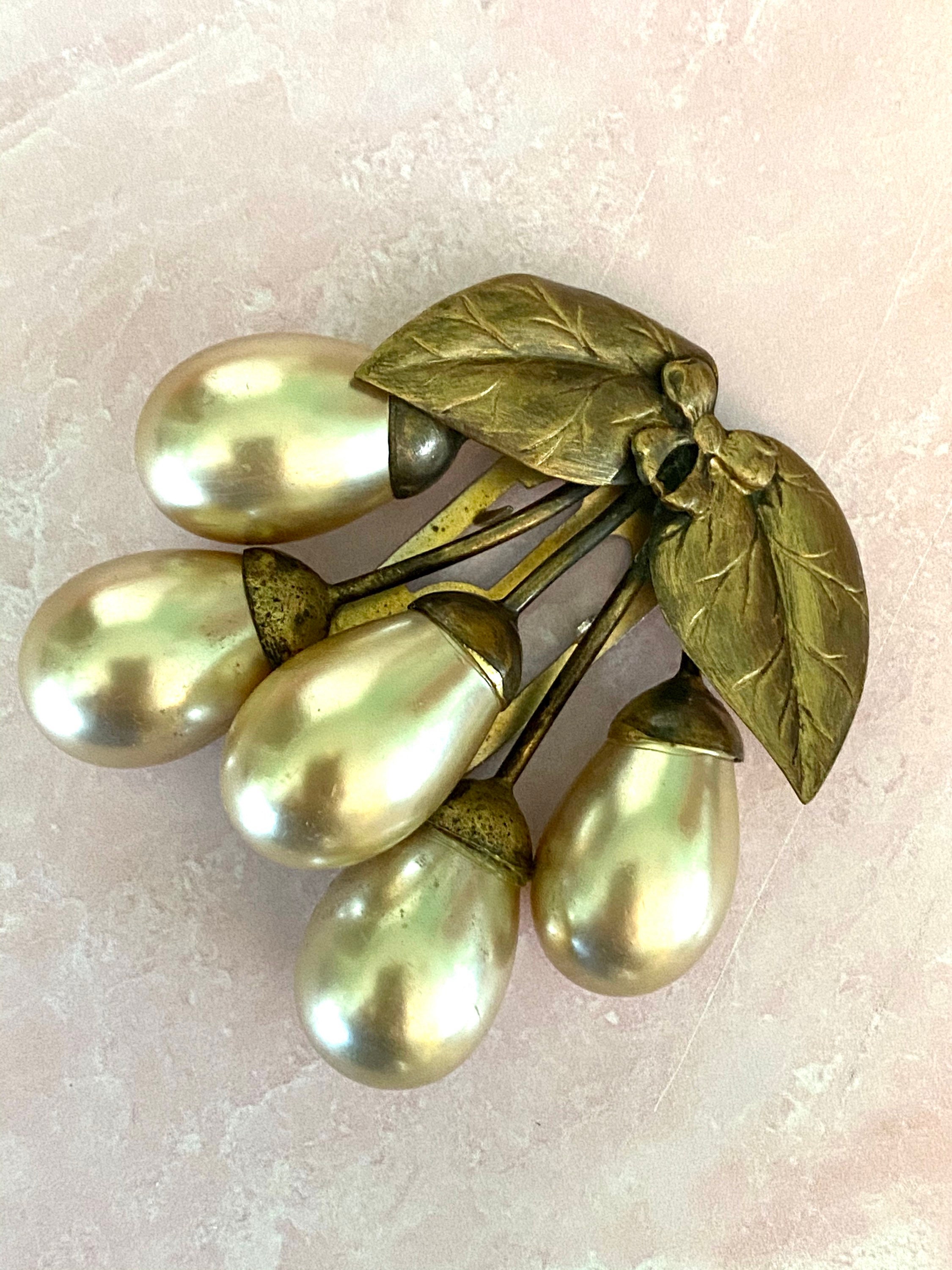




Fabulous Vintage Huge Pearl Dress Clip with Leaves and Bow
$95.00
This listing is for a Fabulous probably 1940's dress clip, beautiful huge pearls that measure 18mm X 20mm. Brooch is 2.5 X 2.5 inches.
Pearls are in good vintage condition, gold is a bit dull and darkened in places, please look at photos.
I have loads of dress clips coming online soon, check for others, they are great to stack on an omega chain to make a great looking necklace. I have included a photo of some dress clips worn as a necklace for reference only.
Photos are part of the description as well, please look carefully. These are in Good Vintage Condition, having good finish and some darkening stones, however condition is consistent with age. Please ask questions or request additional photos, I will be happy to help. All product photos are of the actual item. Colors may differ slightly from actual product appearance due to differences in products and lighting conditions. Please contact me if you have specific additional photo requests as photos are part of the description.
Collectors Weekly has this to say about Dress Clips, Fur Clips, etc...
Dress and fur clips first appeared in the 1920s, when the concept of costume jewelry was taking the world by storm. Before then, only royalty and celebrities had access to opulent, ostentatious fine jewelry bedecked with precious stones like diamonds and emeralds, and so most women's adornment was subtle and tasteful.
But in the Roaring Twenties, Coco Chanel introduced the idea of wearing less-expensive costume jewelry as art, as opposed to wearing fine jewelry to indicate status and wealth. Jewelry then became a subject of experimentation as designers created all sorts of large, bold, and inventive pieces for women looking to spice up plain or neutral items of clothing.
Similar to brooches and pins, dress and fur clips were worn fastened to dresses, furs, and other items of clothing, often to accentuate an alluring detail such as a well-cut lapel or deep neckline. They were made out of the same materials as brooches—sterling silver, bronze, rhinestones, enamels, and plastics like Bakelite—and in similar styles, from Art Deco geometric patterns to floral and figural designs.
Fine jewelry and wristwatch designer Louis Cartier came up with the concept of the double dress clip, which he patented in 1927, a clever device that let two twin clips attach to each other and worn as one brooch. The pieces could also be worn separately as matching dress clips, for example, on either side of a neckline. This versatile design, known as "clip-pins," was such a huge success that in the 1930s, fashion jeweler Coro premiered its own double clip called the Coro Duette.
Trifari also made its own popular spin on the concept, which were known as Clip-Mates. Collectors should note that sellers will often mislabel Clip-Mates as Duettes. Eisenberg, Miriam Haskell, Leo Glass, Fred Block, Mazer, Boucher, Nettie Rosenstein, Hattie Carnegie, and Vogue all made their own versions of clip-pins.
Early Coro pieces were usually Art Deco style with pavé-set clear rhinestones. But the company’s biggest hit was its figural Duettes, which were shaped like flowers, animals, and human characters, decorated with brightly colored enameling and crystal rhinestones, and often sold with matching earrings. Especially popular with collectors are more complicated pieces such as the “Quivering Camelias” Duette, which features trembler flowers on springs.
Worn well into the 1950s, vintage clips seemed to embody the whimsical and creative spirit of costume jewelry, as they could be worn in myriad ways. They could be attached to collars and labels, worn near the throat or off to the side, or at the cleavage. A matching set might be attached to either side of a sweetheart neckline, or to the breast pockets of a jacket. They could be used to hold a scarf in place, or gather the folds of a Grecian-style goddess dress.
Clips were also attached to ribbons to make elegant chokers and necklaces, and one or more could be used to compliment a rhinestone belt buckle or add whimsy to a plain leather belt. Clips were used on clutches and purses to dress them up for an evening out on the town, while shoe clips gave plain pumps a bit of glitz. They even adorned cloche hats and berets. Glamorous celebrities like Joan Crawford, Hedy Lamarr, Esther Williams, Lana Turner, Betty Grable, Ginger Rogers, and Barbara Stanwick often led the way, employing clips in new and interesting ways in their fabulous ensembles.
While many people nowadays use the terms "dress clip" and "fur clip" interchangeably, they are actually distinguished by very different clipping mechanisms. Fur clips, also known as "double-pronged clips" or "pin clips," were long, with a back mechanism featuring two sharp prongs attached to a spring. This design let them pierce the fur without wreaking havoc on it. Fur clips were often adorned with rhinestones or semi-precious stones, or metalwork like repoussé. Coro, Eisenberg, Trifari, Boucher, and Kenneth Lane made fur clips that are among the most coveted today.
Dress clips, on the other had, have a wider and shorter clasp, whose teeth are meant to cling to thinner dress or shirt material. Miriam Haskell, Trifari, Coro, Eisenberg, and Hattie Carnegie were all known for their dress clips. Scarf clips, meanwhile, have stronger hinges but no teeth, while shoe clips are also specialized.
The most valuable dress clips are the ones that come in pairs like the Coro Duettes and the Trifari Clip-Mates. Clip-pin devices that incorporate more than two dress clips are particularly rare. Vintage fur clips with clear stones and high-quality metal finishes are also collectible. All product photos are of the actual item. Colors may differ slightly from actual product appearance due to differences in products and lighting conditions. Please contact me if you have specific additional photo requests as photos are part of the description.
Returns & Exchanges
I don't accept returns, exchanges, or cancellations
But please contact me if you have any problems with your order.
